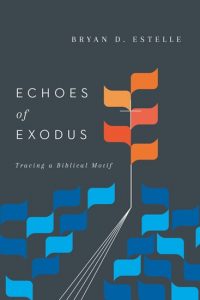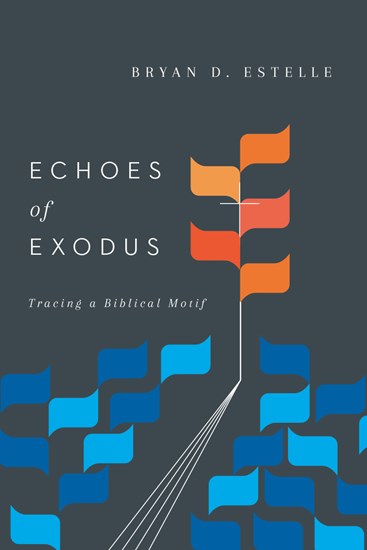Estelle, Bryan D. Echoes of Exodus: Tracing a Biblical Motif. Downers Grove, IL: InterVarsity Press, 2018, pp. 351, $42, paperback.
Bryan D. Estelle is professor of Old Testament at Westminster Seminary, California, where he has taught since 2000. Estelle received his doctorate from The Catholic University of America. He is the author of numerous essays, articles, and books, including Salvation through Judgement and Mercy: The Gospel According to Jonah.
Bryan Estelle takes his readers on a tour de force of one of the Bible’s most significant themes, moving from Creation to the world-to-come in a sweeping survey of texts. On the surface, his book reflects a straight-forward yet comprehensive tracing of the biblical motif of exodus. In reality, Estelle has created a case study rich in methodological insight and hermeneutical acumen. In Chapter 1 he introduces the linguistic and philosophical backgrounds of intertextuality. He follows this discussion by stating his hermeneutical presuppositions and outlining his method for determining an allusion, including carefully clarifying what he means by typology.
In chapter 2 Estelle identifies the cosmic-mountain ideology of the ancient Near East in the Creation account and demonstrates the similarities between creational realities and the Tabernacle. Estelle is clear that both creation and exodus are essentially about a great king forming a people and bringing them to himself at his holy abode (pp. 64, 68, and 93). Estelle helpfully demonstrates that the exodus motif must include all stages of the Israelite journey, from initial deliverance to the wilderness wanderings and then finally to the conquest of Canaan.
Estelle then explores how the Psalter uses the exodus motif in chapter 4, and in chapter 5 Estelle examines Isaiah’s use and adaptation of the exodus motif, demonstrating how Isaiah foretells a coming new and greater exodus and a “way” in the wilderness. Chapter 6 studies the use of the exodus motif within exilic and post-exilic writings by examining Jeremiah and Ezra-Nehemiah.
Chapter 7 discusses how Matthew and Mark develop the exodus motif. According to Estelle, Mark develops Jesus as the one who inaugurates Isaiah’s “way” in the wilderness. Matthew portrays Jesus as a (new) and better Moses, the obedient son, and the one who takes up Israel’s calling. In Chapter 8 Estelle treats Luke-Acts by tracing the use of the “way” terminology throughout the two-volume text, with a particular emphasis on the Gentile inclusion in Jesus’ new exodus.
In chapters 9, 10, and 11, Estelle investigates the use of the exodus motif in the Pauline corpus, in 1 Peter, and in Revelation, respectively. Estelle’s final chapter presents a summary of his findings by suggesting a number of contributions his study makes to the field of Biblical Theology. First, his study of one particular motif validated his appropriation of intertextuality as a method. Second, Estelle reiterates that the exodus motif in the Scriptures must encompass the entire trajectory of exodus from liberation to final destination in God’s presence. For Estelle, the exodus motif can serve as a synecdoche for the story of salvation. Third, Estelle leans heavily on his own terminology of entitlement to the world-to-come as a forensic/legal notion and therefore proposes that the results of his study could inform recent debates on justification by providing a both/and approach rather than an either/or approach. For those interested in further study on intertextuality, Estelle includes a lengthy appendix that provides significantly more background into the linguistic and philosophical background of intertextuality as developed by Kristeva and Bahktin.
Estelle must be applauded for undertaking a study of this magnitude in a consistent and even-handed manner. When compared with Robert and Wilson’s book of the same title from the same year, Estelle’s book is much more rigorous methodologically and thus much more convincing. Estelle’s insistence on defining the exodus trajectory more broadly to include wilderness and the telos of exodus is one of the greatest contributions of his book for Biblical Theology.
In my opinion, chapter 5 (Isaiah’s Rhapsody) was perhaps the heart of the book and functioned to bridge the use of the exodus motif from the Old Testament to the New by highlighting how Isaiah develops and re-imagines this crucial biblical theme. The use of this motif is particularly significant given that each of the Gospels incorporates Isaiah’s use of this motif in their respective introductions.
Often when Estelle presents data regarding the similarities between exodus and creational themes, Estelle appears to prioritize exodus themes and language over creational themes and language with no real rationale for doing so. In this regard Estelle’s exclusion of the Gospel of John for review seems to be a significant miss, given John’s utilization of both creation and (new) exodus language. In his one-page entry on the book of Colossians (p. 284), Estelle appears to be grasping to demonstrate just exactly why the first chapter of Colossians reflects the exodus motif, while failing to mention the obvious creational motifs that are organic to the text. In addition, Estelle’s conclusion that the “influence of the exodus motif on the apostle Paul is pervasive” (p. 285) seems overstated, in that while the motif is present, he fails to demonstrate the motif to be pervasive or controlling.
Due to its comprehensive and technical nature, Estelle’s book will most likely find a home on the shelf of the academic or the serious student of the Word who desire to have a methodologically sound grasp of one of the most important themes for Biblical Theology. Students new to the concept of intertextuality will most likely find his theoretical engagement demanding, while students eager for a case-study in intertextuality will find his book rigorous yet rewarding.
Jared Kaessner
PhD Candidate, Columbia International Seminary





